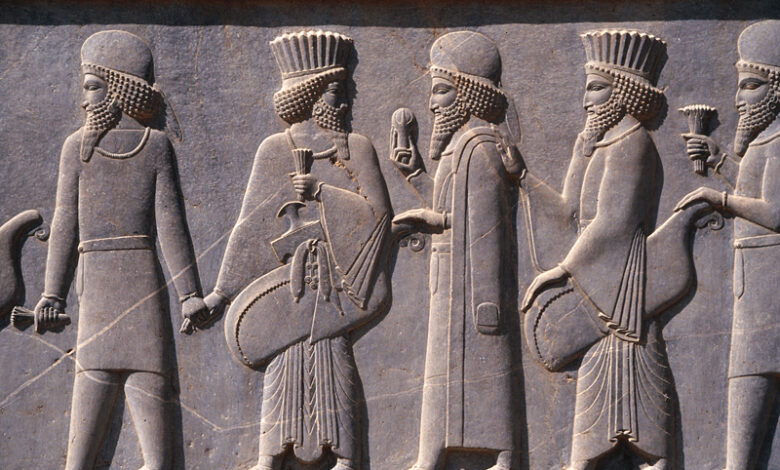
The Persian Empire is the name given to a series of dynasties centered in modern-day Iran that spanned several centuries—from the sixth century B.C. to the twentieth century A.D. The first Persian Empire, founded by Cyrus the Great around 550 B.C., became one of the largest empires in history, stretching from Europe’s Balkan Peninsula in the West to India’s Indus Valley in the East. This Iron Age dynasty, sometimes called the Achaemenid Empire, was a global hub of culture, religion, science, art and technology for more than 200 yearsbefore it fell to the invading armies of Alexander the Great.
Start of the Empire
***The Persian Empire started as a collection of semi-nomadic tribes who raised sheep, goats and cattle on the Iranian plateau.
***Cyrus the Great—the leader of one such tribe—began to defeat nearby kingdoms, including Media, Lydia and Babylon, joining them under one rule. He founded the first Persian Empire, also known as the Achaemenid Empire, in 550 B.C.
***The first Persian Empire under Cyrus the Great soon became the world’s first superpower. It united under one government three important sites of early human civilization in the ancient world: Mesopotamia, Egypt’s Nile Valley and India’s Indus Valley.
***Cyrus the Great is immortalized in the Cyrus Cylinder, a clay cylinder inscribed in 539 BC with the story of how he conquered Babylon from King Nabonidus, bringing an end to the Neo-Babylonian empire.
***Darius the Great, the fourth king of the Achaemenid Empire, ruled over the Persian Empire when it was at its largest, stretching from The Caucasus and West Asia to what was then Macedonia (today’s Balkans), the Black Sea, Central Asia, and even into Africa including parts of Libya and Egypt. He unified the empire through introducing standard currency and weights and measures; making Aramaic the official language and building roads. The Behistun Inscription, a multilingual relief carved into Mount Behistun in Western Iran, extolls his virtues and was a critical key to deciphering cuneiform script. Its impact is compared that of the Rosetta Stone, the tablet that enabled scholars to decipher Egyptian hieroglyphics
?Where Is Persia
At its height under Darius the Great, the Persian Empire stretched from Europe’s Balkan Peninsula—in parts of what is present day Bulgaria, Romania, and Ukraine—to the Indus River Valley in northwest India and south to Egypt.
The Persians were the first people to establish regular routes of communication between three continents—Africa, Asia and Europe. They built many new roads and developed the world’s first postal service.

Persepolis
The ancient Persian capital city of Persepolis, situated in southern Iran, ranks among the world’s greatest archeological sites. It was named a UNESCO World Heritage Site in 1979.
The Achaemenian palaces of Persepolis were built upon massive terraces. They were decorated with ornamental facades that included the long rock relief carvings for which the ancient Persians were famous.

Persian Religion
Many people think of Persia as synonymous with Islam, though Islam only became the dominant religion in the Persian Empire after the Arab conquests of the seventh century. The first Persian Empire was shaped by a different religion: Zoroastrianism.
Named after the Persian prophet Zoroaster (also known as Zarathustra), Zoroastrianism is one of the world’s oldest monotheistic religions. It’s still practiced today as a minority religion in parts of Iran and India..
Zoroaster, who likely lived sometime between 1500 and 500 B.C., taught followers to worship one god instead of the many deities worshipped by earlier Indo-Iranian groups.
The Achaemenian kings were devout Zoroastrians. By most accounts, Cyrus the Great was a tolerant ruler who allowed his subjects to speak their own languages and practice their own religions. While he ruled by the Zoroastrian law of asha (truth and righteousness), he didn’t impose Zoroastrianism on the people of Persia’s conquered territories.
Hebrew scriptures praise Cyrus the Great for freeing the Jewish people of Babylon from captivity and allowing them to return to Jerusalem.
Subsequent rulers in the Achaemenid Empire followed Cyrus the Great’s hands-off approach to social and religious affairs, allowing Persia’s diverse citizenry to continue practicing their own ways of life. This period of time is sometimes called the Pax Persica, or Persian Peace.
Fall of the Persian Empire
The Persian Empire entered a period of decline after a failed invasion of Greece by Xerxes I in 480 BC. The costly defense of Persia’s lands depleted the empire’s funds, leading to heavier taxation among Persia’s subjects.
The Achaemenid dynasty finally fell to the invading armies of Alexander the Great of Macedon in 330 B.C. Subsequent rulers sought to restore the Persian Empire to its Achaemenian boundaries, though the empire never quite regained the enormous size it had achieved under Cyrus the Great.







